Fractal Dimensions of Biomass Burning Aerosols from TEM Images Using the Box-Grid and Nested Squares Methods
Abstract
1. Introduction
2. Materials and Methods
2.1. Nested Square Method (NSM)
2.2. Box-Grid Method (BGM)
3. Results
4. Discussions
4.1. Comparing Fractal Dimensions with the Literature Values
4.2. BGM Considerations
4.3. NSM Considerations
5. Conclusions
Supplementary Materials
Author Contributions
Funding
Institutional Review Board Statement
Informed Consent Statement
Acknowledgments
Conflicts of Interest
References
- Bond, T.C.; Doherty, S.J.; Fahey, D.W.; Forster, P.M.; Berntsen, T.; DeAngelo, B.J.; Flanner, M.G.; Ghan, S.; Kärcher, B.; Koch, D.; et al. Bounding the role of black carbon in the climate system: A scientific assessment. J. Geophys. Res. Atmos. 2013, 118, 5380–5552. [Google Scholar]
- Bond, T.C. Aerosol properties at a midlatitude northern hemisphere continental site. J. Geophys. Res. Atmos. 2001, 106, 3019–3032. [Google Scholar]
- Andreae, M.O. Emission of trace gases and aerosols from biomass burning—An updated assessment. Atmos. Chem. Phys. 2019, 19, 8523–8546. [Google Scholar] [CrossRef]
- Jiang, H.; Frie, A.L.; Lavi, A.; Chen, J.Y.; Zhang, H.; Bahreini, R.; Lin, Y.H. Brown Carbon Formation from Nighttime Chemistry of Unsaturated Heterocyclic Volatile Organic Compounds. Environ. Sci. Technol. Lett. 2019, 6, 184–190. [Google Scholar] [CrossRef]
- Chakrabarty, R.K.; Moosmüller, H.; Garro, M.A.; Arnott, W.P.; Walker, J.; Susott, R.A.; Babbitt, R.E.; Wold, C.E.; Lincoln, E.N.; Hao, W.M. Emissions from the laboratory combustion of wildland fuels: Particle morphology and size. J. Geophys. Res. Atmos. 2006, 111, 6659. [Google Scholar] [CrossRef]
- Reid, J.S.; Eck, T.F.; Christopher, S.A.; Koppmann, R.; Dubovik, O.; Eleuterio, D.P.; Holben, B.N.; Reid, E.A.; Zhang, J. A review of biomass burning emissions part III: Intensive optical properties of biomass burning particles. Atmos. Chem. Phys. 2005, 5, 827–849. [Google Scholar] [CrossRef]
- Martinsson, J.; Eriksson, A.C.; Nielsen, I.E.; Malmborg, V.B.; Ahlberg, E.; Andersen, C.; Lindgren, R.; Nystrom, R.; Nordin, E.Z.; Brune, W.H.; et al. Impacts of Combustion Conditions and Photochemical Processing on the Light Absorption of Biomass Combustion Aerosol. Environ. Sci. Technol. 2015, 49, 14663–14671. [Google Scholar] [CrossRef] [PubMed]
- Smith, D.M.; Fiddler, M.N.; Pokhrel, R.P.; Bililign, S. Laboratory studies of fresh and aged biomass burning aerosols emitted from east African biomass fuels—Part 1—Optical properties. Atmos. Chem. Phys. Discuss. 2020, 2020, 1–30. [Google Scholar] [CrossRef]
- Bond, T.C.; Bergstrom, R.W. Light Absorption by Carbonaceous Particles: An Investigative Review. Aerosol Sci. Technol. 2006, 40, 27–67. [Google Scholar] [CrossRef]
- Chen, Y.; Bond, T.C. Light absorption by organic carbon from wood combustion. Atmos. Chem. Phys. 2010, 10, 1773–1787. [Google Scholar] [CrossRef]
- Lack, D.A.; Langridge, J.M.; Bahreini, R.; Cappa, C.D.; Middlebrook, A.M.; Schwarz, J.P. Brown carbon and internal mixing in biomass burning particles. Proc. Natl. Acad. Sci. USA 2012, 109, 14802–14807. [Google Scholar] [CrossRef] [PubMed]
- Saleh, R.; Robinson, E.S.; Tkacik, D.S.; Ahern, A.T.; Liu, S.; Aiken, A.C.; Sullivan, R.C.; Presto, A.A.; Dubey, M.K.; Yokelson, R.J.; et al. Brownness of organics in aerosols from biomass burning linked to their black carbon content. Nat. Geosci. 2014, 7, 647–650. [Google Scholar] [CrossRef]
- Taylor, J.W.; Wu, H.; Szpek, K.; Bower, K.; Crawford, I.; Flynn, M.J.; Williams, P.I.; Dorsey, J.; Langridge, J.M.; Cotterell, M.; et al. Absorption closure in highly aged biomass burning smoke. Atmos. Chem. Phys. 2020, 20, 11201–11221. [Google Scholar] [CrossRef]
- Samset, B.H.; Stjern, C.W.; Andrews, E.; Kahn, R.A.; Myhre, G.; Schulz, M.; Schuster, G.L. Aerosol Absorption: Progress Towards Global and Regional Constraints. Curr. Clim. Change Rep. 2018, 4, 65–83. [Google Scholar] [CrossRef] [PubMed]
- Saleh, R.; Marks, M.; Heo, J.; Adams, P.J.; Donahue, N.M.; Robinson, A.L. Contribution of brown carbon and lensing to the direct radiative effect of carbonaceous aerosols from biomass and biofuel burning emissions. J. Geophys. Res. Atmos. 2015, 120, 10285–10296. [Google Scholar] [CrossRef]
- Saleh, R. From Measurements to Models: Toward Accurate Representation of Brown Carbon in Climate Calculations. Curr. Pollut. Rep. 2020, 6, 90–104. [Google Scholar] [CrossRef]
- Mishchenko, M.I.; Cairns, B.; Hansen, J.E.; Travis, L.D.; Burg, R.; Kaufman, Y.J.; Martins, J.V.; Shettle, E.P. Monitoring of aerosol forcing of climate from space: Analysis of measurement requirements. J. Quant. Spectrosc. Radiat. Transf. 2004, 88, 149–161. [Google Scholar] [CrossRef]
- Liu, L.; Mishchenko, M.I. Effects of aggregation on scattering and radiative properties of soot aerosols. J. Geophys. Res. Atmos. 2005, 110, 5649. [Google Scholar] [CrossRef]
- Cheng, T.; Gu, X.; Wu, Y.; Chen, H.; Yu, T. The optical properties of absorbing aerosols with fractal soot aggregates: Implications for aerosol remote sensing. J. Quant. Spectrosc. Radiat. Transf. 2013, 125, 93–104. [Google Scholar] [CrossRef]
- Schwarz, J.P.; Spackman, J.R.; Fahey, D.W.; Gao, R.S.; Lohmann, U.; Stier, P.; Watts, L.A.; Thomson, D.S.; Lack, D.A.; Pfister, L.; et al. Coatings and their enhancement of black carbon light absorption in the tropical atmosphere. J. Geophys. Res. Atmos. 2008, 113, 9042. [Google Scholar] [CrossRef]
- Kahnert, M.; Nousiainen, T.; Lindqvist, H.; Ebert, M. Optical properties of light absorbing carbon aggregates mixed with sulfate: Assessment of different model geometries for climate forcing calculations. Opt. Express 2012, 20, 10042–10058. [Google Scholar] [CrossRef] [PubMed]
- Li, J.; Pósfai, M.; Hobbs, P.V.; Buseck, P.R. Individual aerosol particles from biomass burning in southern Africa: 2, Compositions and aging of inorganic particles. J. Geophys. Res. Atmos. 2003, 108, 2310. [Google Scholar] [CrossRef]
- McClure, C.D.; Lim, C.Y.; Hagan, D.H.; Kroll, J.H.; Cappa, C.D. Biomass-burning-derived particles from a wide variety of fuels—Part 1: Properties of primary particles. Atmos. Chem. Phys. 2020, 20, 1531–1547. [Google Scholar] [CrossRef]
- Cai, J.; Lu, N.; Sorensen, C.M. Comparison of size and morphology of soot aggregates as determined by light scattering and electron microscope analysis. Langmuir 1993, 9, 2861–2867. [Google Scholar] [CrossRef]
- Köylu, Ü.; Xing, Y.; Rosner, D.E. Fractal morphology analysis of combustion-generated aggregates using angular light scattering and electron microscope images. Langmuir 1995, 11, 4848–4854. [Google Scholar] [CrossRef]
- Oh, C.; Sorensen, C.M. The Effect of Overlap between Monomers on the Determination of Fractal Cluster Morphology. J. Colloid Interface Sci. 1997, 193, 17–25. [Google Scholar] [CrossRef]
- Sorensen, C.M. Light Scattering by Fractal Aggregates: A Review. Aerosol Sci. Technol. 2001, 35, 648–687. [Google Scholar] [CrossRef]
- Sorensen, C.M.; Feke, G.D. The Morphology of Macroscopic Soot. Aerosol Sci. Technol. 1996, 25, 328–337. [Google Scholar] [CrossRef]
- Chakrabarty, R.K.; Garro, M.A.; Garro, B.A.; Chancellor, S.; Moosmüller, H.; Herald, C.M. Simulation of Aggregates with Point-Contacting Monomers in the Cluster-Dilute Regime. Part 2: Comparison of Two- and Three-Dimensional Structural Properties as a Function of Fractal Dimension. Aerosol Sci. Technol. 2011, 45, 903–908. [Google Scholar] [CrossRef]
- Brasil, A.; Farias, T.; Carvalho, M. Evaluation of the Fractal Properties of Cluster? Cluster Aggregates. Aerosol Sci. Technol. 2000, 33, 440–454. [Google Scholar] [CrossRef]
- Chakrabarty, R.K.; Beres, N.D.; Moosmüller, H.; China, S.; Mazzoleni, C.; Dubey, M.K.; Liu, L.; Mishchenko, M.I. Soot superaggregates from flaming wildfires and their direct radiative forcing. Sci. Rep. 2014, 4, 5508. [Google Scholar] [CrossRef] [PubMed]
- China, S.; Mazzoleni, C.; Gorkowski, K.; Aiken, A.C.; Dubey, M.K. Morphology and mixing state of individual freshly emitted wildfire carbonaceous particles. Nat. Commun. 2013, 4, 2122. [Google Scholar] [CrossRef] [PubMed]
- Pang, Y.; Wang, Y.; Wang, Z.; Zhang, Y.; Liu, L.; Kong, S.; Liu, F.; Shi, Z.; Li, W. Quantifying the Fractal Dimension and Morphology of Individual Atmospheric Soot Aggregates. J. Geophys. Res. Atmos. 2022, 127, e2021JD036055. [Google Scholar] [CrossRef]
- Pashminehazar, R. Determination of fractal dimension and prefactor of agglomerates with irregular structure. Powder Technol. 2019, 343, 9. [Google Scholar] [CrossRef]
- Sarpong, E.; Smith, D.; Pokhrel, R.; Fiddler, M.N.; Bililign, S. Refractive Indices of Biomass Burning Aerosols Obtained from African Biomass Fuels using RDG Approximations. Atmopshere 2020, 11, 62. [Google Scholar] [CrossRef]
- Sorensen, C.M.; Yon, J.; Liu, F.; Maughan, J.; Heinson, W.R.; Berg, M.J. Light scattering and absorption by fractal aggregates including soot. J. Quant. Spectrosc. Radiat. Transf. 2018, 217, 459–473. [Google Scholar] [CrossRef]
- Husain, A.; Nanda, M.N.; Chowdary, M.S.; Sajid, M. Fractals: An Eclectic Survey, Part-I. Fractal Fract. 2022, 6, 89. [Google Scholar] [CrossRef]
- Husain, A.; Nanda, M.N.; Chowdary, M.S.; Sajid, M. Fractals: An Eclectic Survey, Part II. Fractal Fract. 2022, 6, 379. [Google Scholar] [CrossRef]
- Lee, C.; Kramer, T.A. Prediction of three-dimensional fractal dimensions using the two-dimensional properties of fractal aggregates. Adv. Colloid Interface Sci. 2004, 112, 49–57. [Google Scholar] [CrossRef]
- Pandey, A.; Chakrabarty, R.K.; Liu, L.; Mishchenko, M.I. Empirical relationships between optical properties and equivalent diameters of fractal soot aggregates at 550 nm wavelength. Opt. Express 2015, 23, A1354–A1362. [Google Scholar] [CrossRef]
- Wang, Y.; Liu, F.; He, C.; Bi, L.; Cheng, T.; Wang, Z.; Zhang, H.; Zhang, X.; Shi, Z.; Li, W. Fractal Dimensions and Mixing Structures of Soot Particles during Atmospheric Processing. Environ. Sci. Technol. Lett. 2017, 4, 487–493. [Google Scholar] [CrossRef]
- Katrinak, K.A.; Rez, P.; Perkes, P.R.; Buseck, P.R. Fractal geometry of carbonaceous aggregates from an urban aerosol. Environ. Sci. Technol. 1993, 27, 539–547. [Google Scholar] [CrossRef]
- Chakrabarty, R.K.; Moosmüller, H.; Arnott, W.P.; Garro, M.A.; Slowik, J.G.; Cross, E.S.; Han, J.H.; Davidovits, P.; Onasch, T.B.; Worsnop, D.R. Light scattering and absorption by fractal-like carbonaceous chain aggregates: Comparison of theories and experiment. Appl. Opt. 2007, 46, 6990–7006. [Google Scholar] [CrossRef] [PubMed]
- Jullien, R.; Thouy, R.; Ehrburger-Dolle, F. Numerical investigation of two-dimensional projections of random fractal aggregates. Phys. Rev. E 1994, 50, 3878–3882. [Google Scholar] [CrossRef]
- Smith, D.M.; Cui, T.; Fiddler, M.N.; Pokhrel, R.P.; Surratt, J.D.; Bililign, S. Laboratory studies of fresh and aged biomass burning aerosols emitted from east African biomass fuels—Part 2: Chemical properties and characterization. Atmos. Chem. Phys. Discuss. 2020, 2020, 1–30. [Google Scholar] [CrossRef]
- Yokelson, R.J.; Griffith, D.W.T.; Ward, D.E. Open-path Fourier transform infrared studies of large-scale laboratory biomass fires. J. Geophys. Res. Atmos. 1996, 101, 21067–21080. [Google Scholar] [CrossRef]
- Pokhrel, R.P.; Gordon, J.; Fiddler, M.N.; Bililign, S. Impact of combustion conditions on physical and morphological properties of biomass burning aerosol. Aerosol Sci. Technol. 2021, 55, 80–91. [Google Scholar] [CrossRef]
- Chakrabarty, R.K.; Garro, M.A.; Garro, B.A.; Chancellor, S.; Moosmüller, H.; Herald, C.M. Simulation of Aggregates with Point-Contacting Monomers in the Cluster–Dilute Regime. Part 1: Determining the Most Reliable Technique for Obtaining Three-Dimensional Fractal Dimension from Two-Dimensional Images. Aerosol Sci. Technol. 2011, 45, 75–80. [Google Scholar] [CrossRef]
- Wu, J.; Jin, X.; Mi, S.; Tang, J. An effective method to compute the box-counting dimension based on the mathematical definition and intervals. Results Eng. 2020, 6, 100106. [Google Scholar] [CrossRef]
- Ostwald, M.J. The Fractal Analysis of Architecture: Calibrating the Box-Counting Method Using Scaling Coefficient and Grid Disposition Variables. Environ. Plan. B Plan. Des. 2013, 40, 644–663. [Google Scholar] [CrossRef]
- Xu, Y.; Serre, M.L.; Reyes, J.M.; Vizuete, W. Impact of temporal upscaling and chemical transport model horizontal resolution on reducing ozone exposure misclassification. Atmos. Environ. 2017, 166, 374–382. [Google Scholar] [CrossRef]
- Zhang, L.; Dang, F.; Ding, W.; Zhu, L. Quantitative study of meso-damage process on concrete by CT technology and improved differential box counting method. Measurement 2020, 160, 107832. [Google Scholar] [CrossRef]
- Husain, A.; Reddy, J.; Bisht, D.; Sajid, M. Fractal dimension of coastline of Australia. Sci. Rep. 2021, 11, 6304. [Google Scholar] [CrossRef] [PubMed]
- McDonald, R.; Biswas, P. A methodology to establish the morphology of ambient aerosols. J. Air Waste Manag. Assoc. 2004, 54, 1069–1078. [Google Scholar] [CrossRef] [PubMed]
- Chen, L.W.; Moosmüller, H.; Arnott, W.P.; Chow, J.C.; Watson, J.G.; Susott, R.A.; Babbitt, R.E.; Wold, C.E.; Lincoln, E.N.; Hao, W.M. Particle emissions from laboratory combustion of wildland fuels: In situ optical and mass measurements. Geophys. Res. Lett. 2006, 33, 24838. [Google Scholar] [CrossRef]
- Wentzel, M.; Gorzawski, H.; Naumann, K.-H.; Saathoff, H.; Weinbruch, S. Transmission Electron Microscopical and Aerosol Dynamical Characterization of Soot Aerosols. J. Aerosol Sci. 2003, 34, 1347–1370. [Google Scholar] [CrossRef]
- Köylü, Ü.Ö.; McEnally, C.S.; Rosner, D.E.; Pfefferle, L.D. Simultaneous measurements of soot volume fraction and particle size/microstructure in flames using a thermophoretic sampling technique. Combust. Flame 1997, 110, 494–507. [Google Scholar] [CrossRef]
- Manfred, K.M. Investigating biomass burning aerosol morphology using a laser imaging nephelometer. Atmospheic Chem. Phys. 2018, 18, 15. [Google Scholar] [CrossRef]
- Dye, A.L.; Rhead, M.M.; Trier, C.J. The quantitative morphology of roadside and background urban aerosol in Plymouth, UK. Atmos. Environ. 2000, 34, 3139–3148. [Google Scholar] [CrossRef]
- Samson, R.J.; Mulholland, G.W.; Gentry, J.W. Structural analysis of soot agglomerates. Langmuir 1987, 3, 272–281. [Google Scholar] [CrossRef]
- Smith, A.; Grainger, R. Simplifying the calculation of light scattering properties for black carbon fractal aggregates. Atmos. Chem. Phys. 2014, 14, 7825–7836. [Google Scholar] [CrossRef]
- Wu, Y.; Cheng, T.; Zheng, L.; Chen, H. Optical properties of the semi-external mixture composed of sulfate particle and different quantities of soot aggregates. J. Quant. Spectrosc. Radiat. Transf. 2016, 179, 139–148. [Google Scholar] [CrossRef]
- Filippov, A.V.; Zurita, M.; Rosner, D.E. Fractal-like Aggregates: Relation between Morphology and Physical Properties. J. Colloid Interface Sci. 2000, 229, 261–273. [Google Scholar] [CrossRef] [PubMed]
- Wang, Y.; Li, W.; Huang, J.; Liu, L.; Pang, Y.; He, C.; Liu, F.; Liu, D.; Bi, L.; Zhang, X.; et al. Nonlinear Enhancement of Radiative Absorption by Black Carbon in Response to Particle Mixing Structure. Geophys. Res. Lett. 2021, 48, e2021GL096437. [Google Scholar] [CrossRef]
- Li, J.; Du, Q.; Sun, C. An improved box-counting method for image fractal dimension estimation. Pattern Recognit. 2009, 42, 2460–2469. [Google Scholar] [CrossRef]
- Dubuc, B.; Zucker, S.W.; Tricot, C.; Quiniou, J.F.; Wehbi, D. Evaluating the Fractal Dimension of Surfaces. Proc. R. Soc. Lond. Ser. A Math. Phys. Sci. 1989, 425, 113–127. [Google Scholar]
- Bouda, M.; Caplan, J.S.; Saiers, J.E. Box-Counting Dimension Revisited: Presenting an Efficient Method of Minimizing Quantization Error and an Assessment of the Self-Similarity of Structural Root Systems. Front. Plant Sci. 2016, 7, 149. [Google Scholar] [CrossRef]
- Klinkenberg, B. A review of methods used to determine the fractal dimension of linear features. Math. Geol. 1994, 26, 23–46. [Google Scholar] [CrossRef]
- Brasil, A.; Farias, T.L.; Carvalho, M. A recipe for image characterization of fractal-like aggregates. J. Aerosol Sci. 1999, 30, 1379–1389. [Google Scholar] [CrossRef]
- Tence, M.; Chevalier, J.P.; Jullien, R. On the measurement of the fractal dimension of aggregated particles by electron microscopy: Experimental method, corrections and comparison with numerical models. J. Phys. Fr. 1986, 47, 1989–1998. [Google Scholar] [CrossRef]
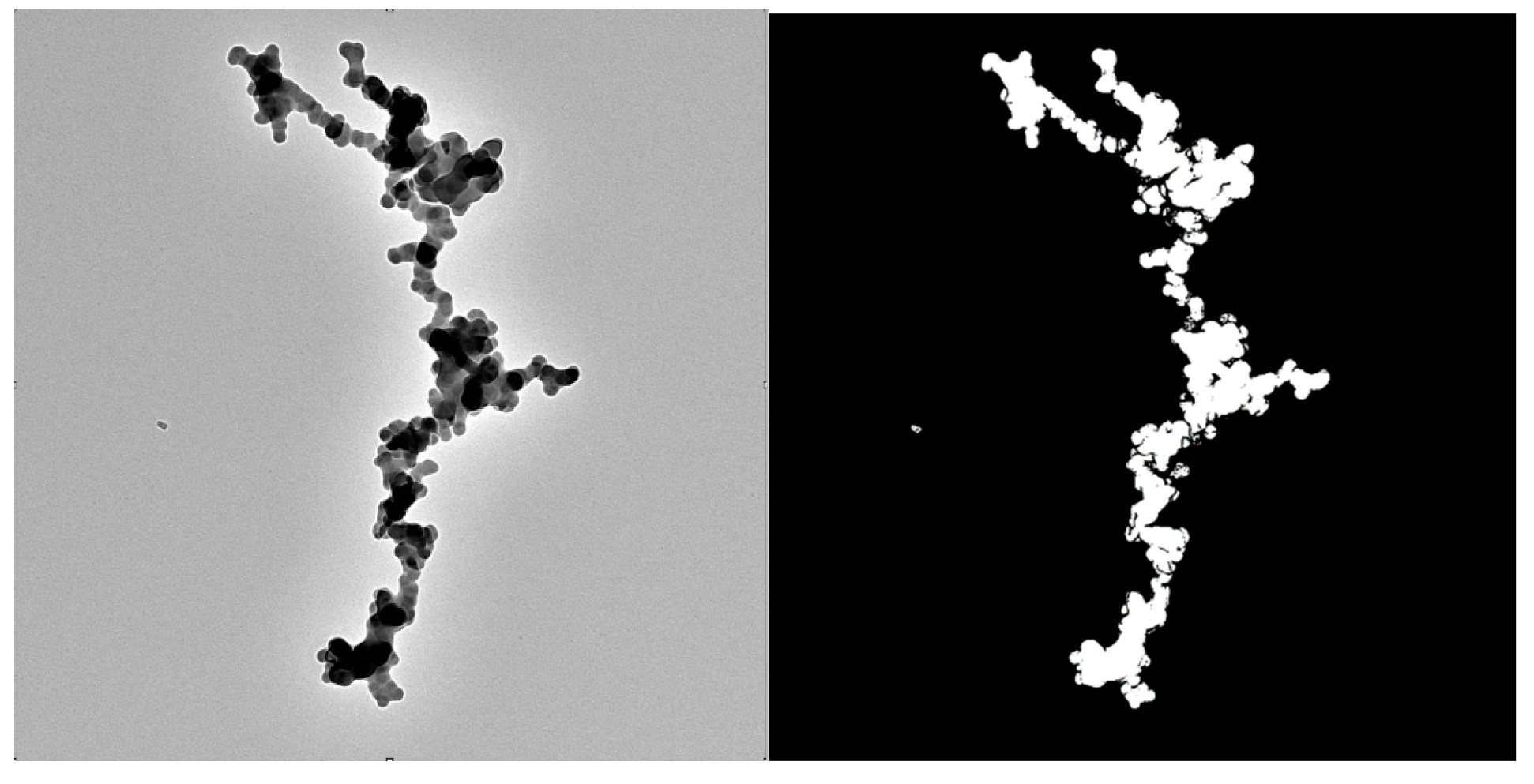
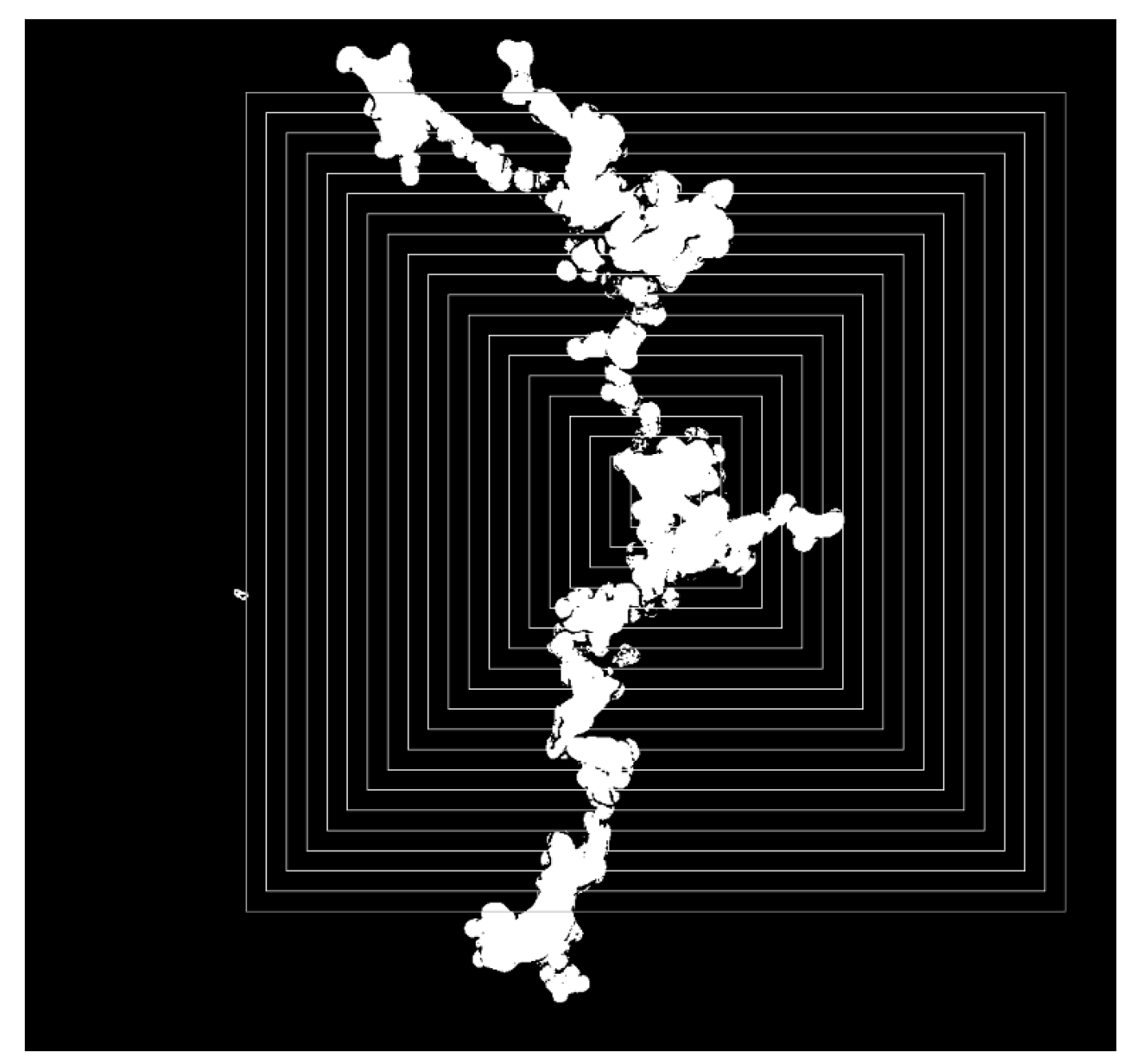
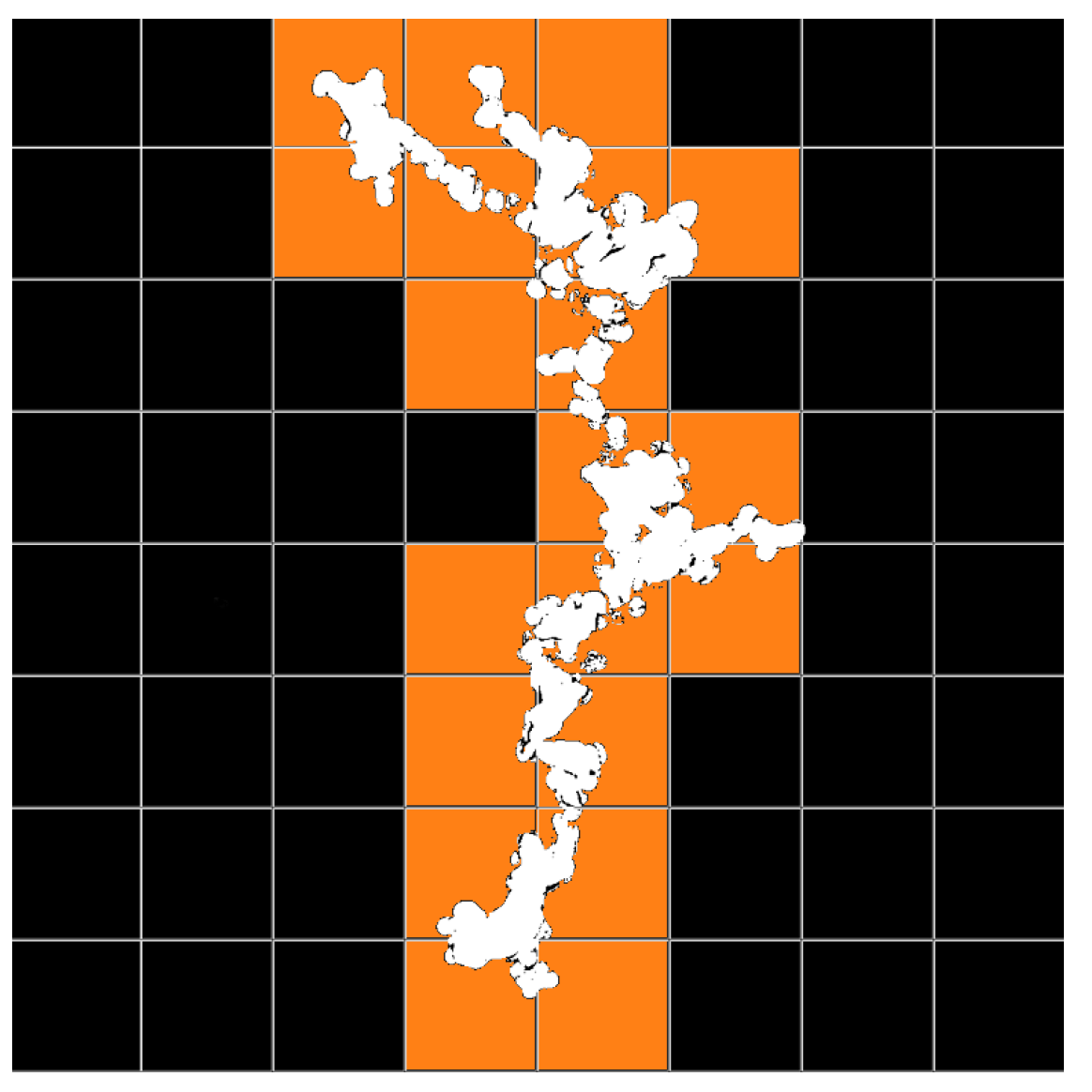
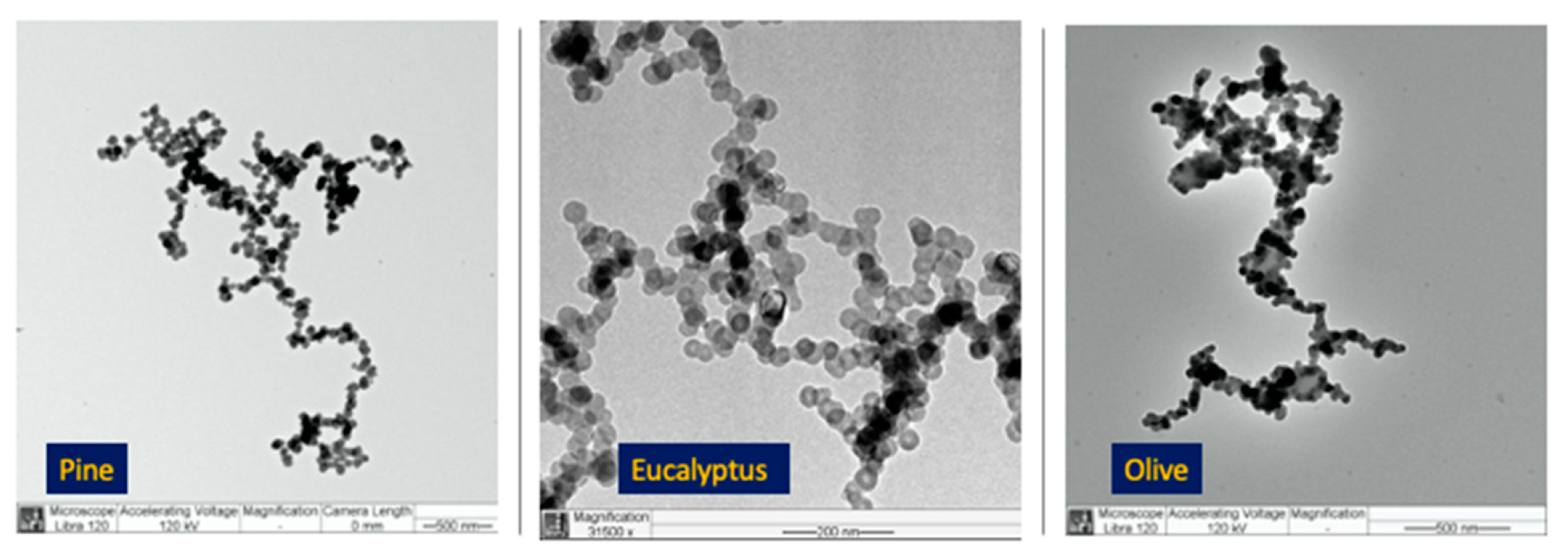

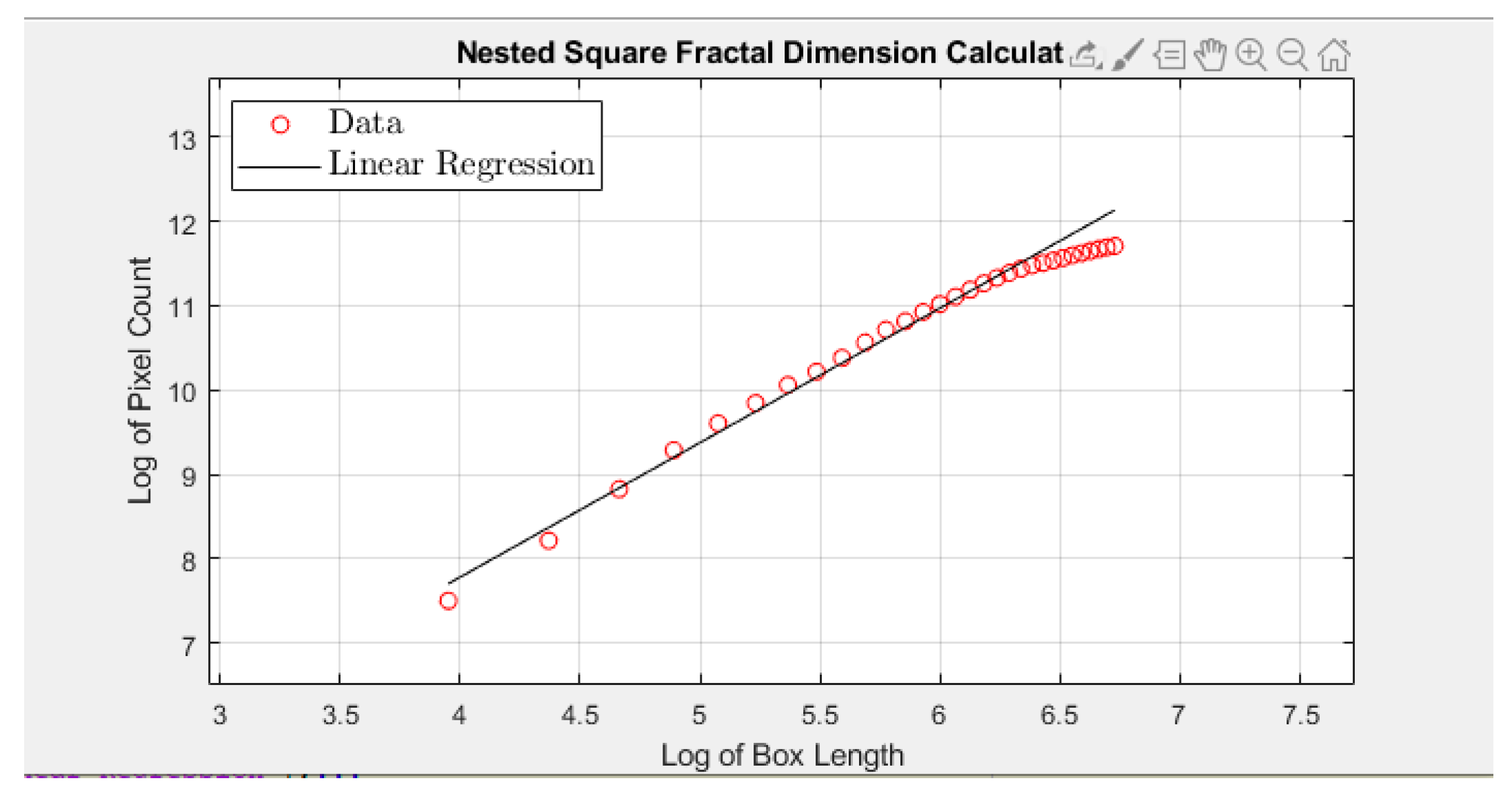
| Nested Square Method | Box-Grid Method | |||||
|---|---|---|---|---|---|---|
| Sample | Dp | Df (Equation (3)) | Df (Equation (4)) | Dp | Df (Equation (3)) | Df (Equation (4)) |
| Eucalyptus 1 (MCE = 0.96) | 1.73 ± 0.07 | 2.43 ± 0.13 | 1.82 ± 0.07 | 1.72 ± 0.07 | 2.44 ± 0.11 | 1.81 ± 0.06 |
| Eucalyptus 2 (MCE = 0.99) | 1.74 ± 0.07 | 2.41 ± 0.12 | 1.83 ± 0.07 | 1.73 ± 0.06 | 2.43 ± 0.10 | 1.82 ± 0.06 |
| Olive (MCE = 0.99) | 1.63 ± 0.15 | 2.61 ± 0.27 | 1.74 ± 0.11 | 1.6 ± 0.11 | 2.66 ± 0.19 | 1.72 ± 0.08 |
| Pine (MCE = 0.99) | 1.59 ± 0.07 | 2.68 ± 0.07 | 1.70 ± 0.05 | 1.58 ± 0.07 | 2.69 ± 0.12 | 1.70 ± 0.04 |
Disclaimer/Publisher’s Note: The statements, opinions and data contained in all publications are solely those of the individual author(s) and contributor(s) and not of MDPI and/or the editor(s). MDPI and/or the editor(s) disclaim responsibility for any injury to people or property resulting from any ideas, methods, instructions or products referred to in the content. |
© 2023 by the authors. Licensee MDPI, Basel, Switzerland. This article is an open access article distributed under the terms and conditions of the Creative Commons Attribution (CC BY) license (https://creativecommons.org/licenses/by/4.0/).
Share and Cite
Honablew, T.; Fiddler, M.N.; Pokhrel, R.P.; Bililign, S. Fractal Dimensions of Biomass Burning Aerosols from TEM Images Using the Box-Grid and Nested Squares Methods. Atmosphere 2023, 14, 221. https://doi.org/10.3390/atmos14020221
Honablew T, Fiddler MN, Pokhrel RP, Bililign S. Fractal Dimensions of Biomass Burning Aerosols from TEM Images Using the Box-Grid and Nested Squares Methods. Atmosphere. 2023; 14(2):221. https://doi.org/10.3390/atmos14020221
Chicago/Turabian StyleHonablew, Timothy, Marc N. Fiddler, Rudra P. Pokhrel, and Solomon Bililign. 2023. "Fractal Dimensions of Biomass Burning Aerosols from TEM Images Using the Box-Grid and Nested Squares Methods" Atmosphere 14, no. 2: 221. https://doi.org/10.3390/atmos14020221
APA StyleHonablew, T., Fiddler, M. N., Pokhrel, R. P., & Bililign, S. (2023). Fractal Dimensions of Biomass Burning Aerosols from TEM Images Using the Box-Grid and Nested Squares Methods. Atmosphere, 14(2), 221. https://doi.org/10.3390/atmos14020221







